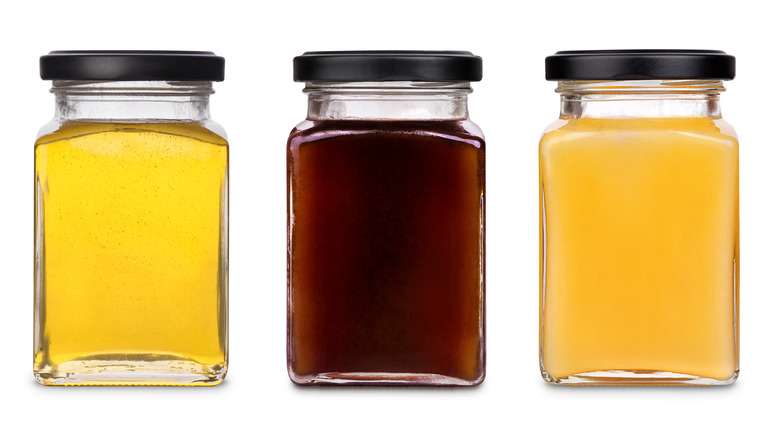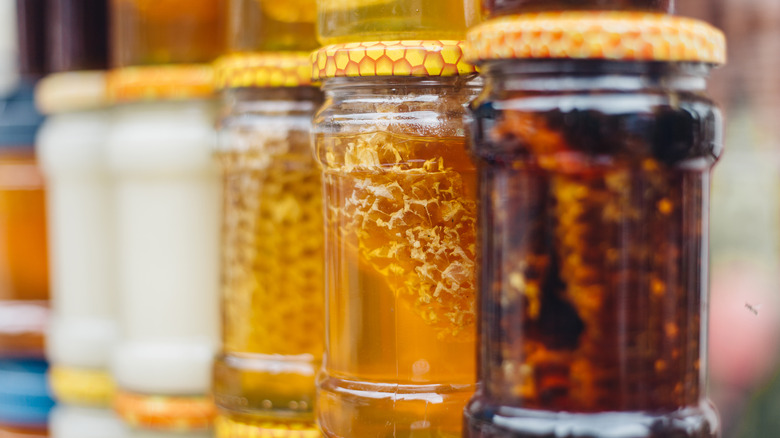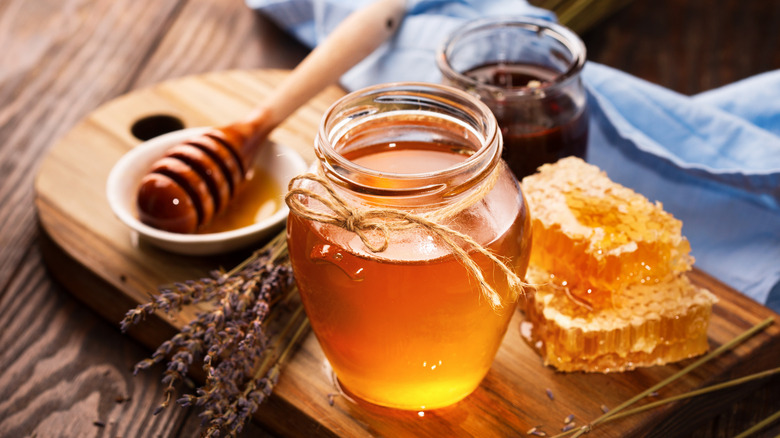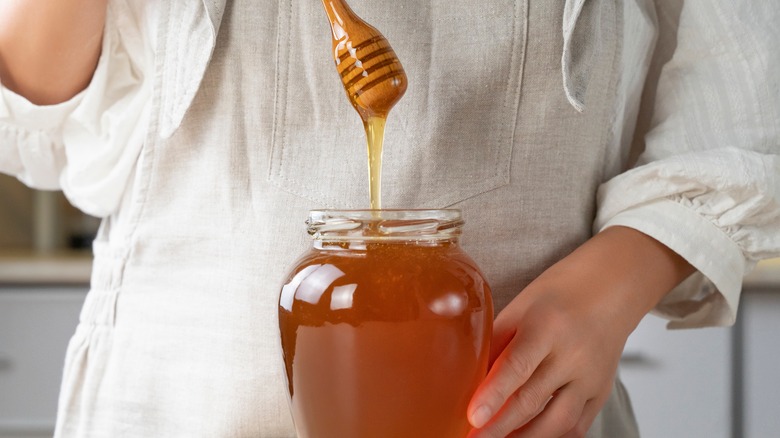What Is The Difference Between Dark And Light Honey?
You could argue that one of nature's best gifts is honey. It's sweet, floral, and natural, and has a pleasant texture and mouth feel. Having a little honey bear container in your pantry can be a comfort when you want to sweeten a cup of tea or add some flavor to your favorite oatmeal or stack of pancakes. It's a worthy substitute for sugar in baking recipes and it even contains antioxidants that fight off free radicals (per MasterClass). The world has honeybees to thank for this sweet treat as they pollinate flowers and then turn their nectar into a collectible, natural sweetener.
When it comes to honey, what do the different colors mean? From light-colored honey all the way to dark manuka varieties, what are the similarities and differences between the different types? Read on to learn more about what differentiates dark honey from light honey as well as some of the best properties of both types.
Honey colors, light to dark
The colors of honey exist on a spectrum from super light-colored honey to very dark-colored honey. Some of the lighter varieties are less intense and more floral, while the darker varieties can be a bit more concentrated in texture and flavor.
The color of honey depends on two factors, according to BeehiveHero: the flowers involved in the making of the honey and the level of heat surrounding the hive when the honey was being produced. MasterClass notes that some plants that create darker honey are buckwheat, wildflower, avocado blossoms, and thyme. Lighter varieties of honey may be dependent upon the time of year when the honey was made and in what flowering stage the plant was when it was visited by the bees. Beehive Hero also notes that warmer temperatures tend to produce darker honey, although it's also possible for honey to darken in the bottle or jar if it's surrounded by higher heat during its shelf life.
Honey flavor profiles
The flavor of honey is directly correlated to color. The National Honey Board notes that lighter-colored honey tends to be milder in flavor, while darker honey has a more concentrated, rich flavor, closer in comparison to molasses or malt.
Depending on the kind of flavor you're looking for, you might choose a lighter honey or a darker honey. Some varieties of lighter honey with more delicate, floral flavors are clover, alfalfa, and orange blossom honeys. While darker honeys with more intense flavors include varieties like avocado, buckwheat, eucalyptus, manuka, or Tupelo honey.
If you are looking for a subtle honey flavor in a recipe, using a lighter variety might be preferred. However, if you're looking to pack a punch and have a deeper, more pungent honey flavor, choose a darker variety. The darker the honey the less water it has (per BeehiveHero), so the thicker and more viscous it will be. It will also be more densely packed with flavor as well as nutritional benefits.
Honey nutritional properties
Because darker honey contains less water than its lighter cousins, that means that the nutritional benefits of darker honey are more amplified than light honey. Really dark, antioxidant rich-varieties like manuka honey can also cost more as they contain more nutritional benefits per measurement, per Eater. If you eat manuka honey or a comparable honey for health benefits, it's often wise to have a less-expensive, lighter variety of honey in your pantry for everyday use like sweetening tea, oatmeal, or salad dressings. Honeys like manuka that are consumed for health or healing benefits are also said to have sharper flavors, per Eater, so they're not as mild and gentle as lighter varieties like clover.
According to Healthline, since honey contains high antioxidant levels it's much better for the body as a sweetener than processed white sugar and it's easier on the body's blood sugar levels. In addition, honey can be used topically to help heal wounds and burns. It's also a good natural cough suppressant.
Where to use each type of honey
When it comes to choosing which honey to use, it really comes down to personal preference. Specialty darker honeys tend to cost more so using them sparingly or frequently is all up to someone's individual preference. When flavoring dishes with honey you might consider what kind of flavor profile you're going for. If you're making a recipe where you might use molasses or maple syrup, then you might opt for darker honey. If you're using honey in a recipe where you might use white granulated sugar then lighter honey could be closer in flavor.
When baking with honey there are a few considerations to make. Allrecipes suggests that you use ¾ cup of honey plus 1 tablespoon in place of each cup of sugar a recipe calls for. They also suggest you decrease your recipe's liquid by about ¼ cup to account for the extra moisture honey will add to the recipe. Add an additional ½ teaspoon of baking soda per every cup of honey used, and lower your baking temperature by 25 degrees Fahrenheit.
Honey is a wonderfully nutritious way to sweeten your life. Whether you choose dark or light honey, it can only make a delicious recipe even tastier.




